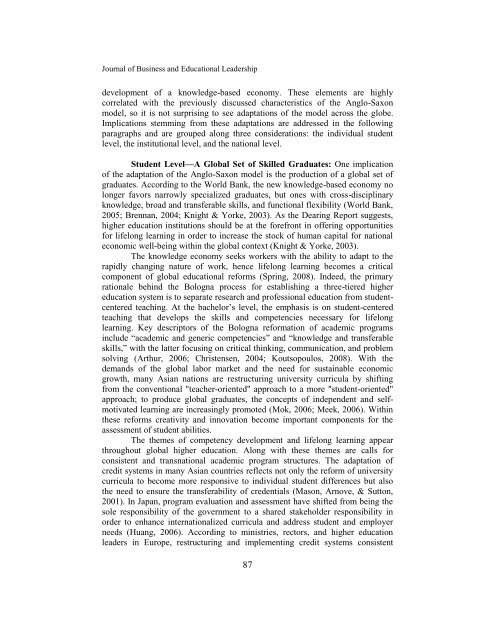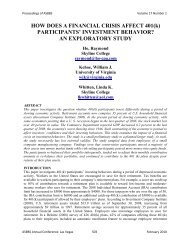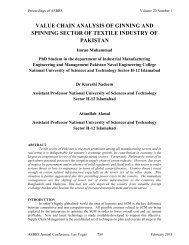journal of business and educational leadership - Asbbs.org
journal of business and educational leadership - Asbbs.org
journal of business and educational leadership - Asbbs.org
You also want an ePaper? Increase the reach of your titles
YUMPU automatically turns print PDFs into web optimized ePapers that Google loves.
Journal <strong>of</strong> Business <strong>and</strong> Educational Leadership<br />
development <strong>of</strong> a knowledge-based economy. These elements are highly<br />
correlated with the previously discussed characteristics <strong>of</strong> the Anglo-Saxon<br />
model, so it is not surprising to see adaptations <strong>of</strong> the model across the globe.<br />
Implications stemming from these adaptations are addressed in the following<br />
paragraphs <strong>and</strong> are grouped along three considerations: the individual student<br />
level, the institutional level, <strong>and</strong> the national level.<br />
Student Level—A Global Set <strong>of</strong> Skilled Graduates: One implication<br />
<strong>of</strong> the adaptation <strong>of</strong> the Anglo-Saxon model is the production <strong>of</strong> a global set <strong>of</strong><br />
graduates. According to the World Bank, the new knowledge-based economy no<br />
longer favors narrowly specialized graduates, but ones with cross-disciplinary<br />
knowledge, broad <strong>and</strong> transferable skills, <strong>and</strong> functional flexibility (World Bank,<br />
2005; Brennan, 2004; Knight & Yorke, 2003). As the Dearing Report suggests,<br />
higher education institutions should be at the forefront in <strong>of</strong>fering opportunities<br />
for lifelong learning in order to increase the stock <strong>of</strong> human capital for national<br />
economic well-being within the global context (Knight & Yorke, 2003).<br />
The knowledge economy seeks workers with the ability to adapt to the<br />
rapidly changing nature <strong>of</strong> work, hence lifelong learning becomes a critical<br />
component <strong>of</strong> global <strong>educational</strong> reforms (Spring, 2008). Indeed, the primary<br />
rationale behind the Bologna process for establishing a three-tiered higher<br />
education system is to separate research <strong>and</strong> pr<strong>of</strong>essional education from studentcentered<br />
teaching. At the bachelor‘s level, the emphasis is on student-centered<br />
teaching that develops the skills <strong>and</strong> competencies necessary for lifelong<br />
learning. Key descriptors <strong>of</strong> the Bologna reformation <strong>of</strong> academic programs<br />
include ―academic <strong>and</strong> generic competencies‖ <strong>and</strong> ―knowledge <strong>and</strong> transferable<br />
skills,‖ with the latter focusing on critical thinking, communication, <strong>and</strong> problem<br />
solving (Arthur, 2006; Christensen, 2004; Koutsopoulos, 2008). With the<br />
dem<strong>and</strong>s <strong>of</strong> the global labor market <strong>and</strong> the need for sustainable economic<br />
growth, many Asian nations are restructuring university curricula by shifting<br />
from the conventional "teacher-oriented" approach to a more "student-oriented"<br />
approach; to produce global graduates, the concepts <strong>of</strong> independent <strong>and</strong> selfmotivated<br />
learning are increasingly promoted (Mok, 2006; Meek, 2006). Within<br />
these reforms creativity <strong>and</strong> innovation become important components for the<br />
assessment <strong>of</strong> student abilities.<br />
The themes <strong>of</strong> competency development <strong>and</strong> lifelong learning appear<br />
throughout global higher education. Along with these themes are calls for<br />
consistent <strong>and</strong> transnational academic program structures. The adaptation <strong>of</strong><br />
credit systems in many Asian countries reflects not only the reform <strong>of</strong> university<br />
curricula to become more responsive to individual student differences but also<br />
the need to ensure the transferability <strong>of</strong> credentials (Mason, Arnove, & Sutton,<br />
2001). In Japan, program evaluation <strong>and</strong> assessment have shifted from being the<br />
sole responsibility <strong>of</strong> the government to a shared stakeholder responsibility in<br />
order to enhance internationalized curricula <strong>and</strong> address student <strong>and</strong> employer<br />
needs (Huang, 2006). According to ministries, rectors, <strong>and</strong> higher education<br />
leaders in Europe, restructuring <strong>and</strong> implementing credit systems consistent<br />
87
















